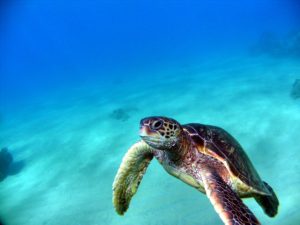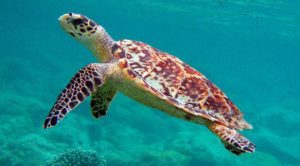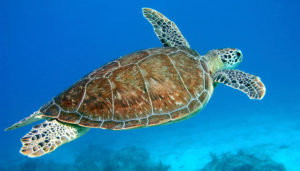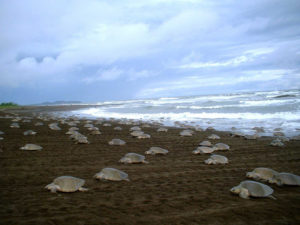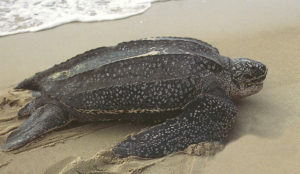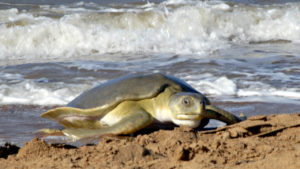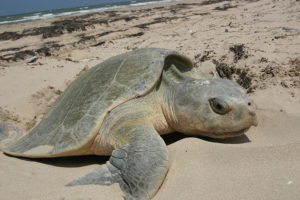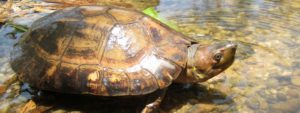Five of seven marine turtle species (Testudines) in the world can be found in the Philippines. These are the Green turtle, Hawksbill, Loggerhead, Olive Ridley, and the Leatherback. These sea turtles are commonly called “Pawikan” in the Philippines. The two other species not present in the Philippines are the Flatback (Natator depressus) and the Kemp’s Ridley (Lepidochelys kempii) sea turtles.
Vulnerability. The International Union for Conservation of Nature and Natural Resources (IUCN) red lists the Hawksbill (Eretmochelys imbricata) as critically endangered; the Green turtle (Chelonia mydas) as endangered; the Loggerhead (Caretta caretta), Olive Ridley (Eretmochelys imbricata), and Leatherback (Dermochelys coriacea) turtles are as vulnerable. The Flatback was previously listed as vulnerable, but due to lack of recent evidentiary data, it is currently listed as data-deficient. The Kemp’s Ridley is listed as critically endangered.
Marine Family. All sea turtle species, except the Leatherback, belong to the family Cheloniidae. The Leatherback belongs to the family Dermochelyidae as the only sea turtle without a hard shell. In general, a sea turtle has a fusiform body type that tapers at both ends of the carapace shell. The resulting smaller volume of the fusiform body means that the sea turtle cannot retract its head, legs, and arms into the shell, like a freshwater turtle can. The sea turtle is an air-breathing reptile that has lungs, thus, it regularly surfaces to breathe. A foraging turtle typically spends 5-40 minutes underwater, while a sleeping sea turtle remains underwater for 4–7 hours.
Philippine Freshwater Turtle. The Philippine Forest turtle (Siebenrockiella leytensis) belongs to the family Geoemydidae, a freshwater specie endemic to the Philippines. The IUCN red lists the Philippine Forest turtle as critically endangered, and is likewise listed in the Top 25 globally threatened turtle species. It is also known as the Philippine pond turtle, the Palawan turtle, or the Leyte Pond turtle. But the Philippine Forest turtle is in fact from the Palawan and Dumaran Islands, not Leyte.
Main Diet. As the Green turtle matures, it becomes exclusively herbivorous. The Hawksbill principally eats sponges. The Leatherback feeds almost exclusively on jellyfish and this helps control jellyfish populations. The rest of the sea turtles –Loggerhead, Olive Ridley, Flatback, and Kemp’s Ridley– are omnivorous, as they can eat sea cucumbers, jellyfish, mollusks, prawns, bryozoans, invertebrates, and seaweed. The Philippine Forest turtle is also omnivorous.
Body Length and Weight.
The Green turtle can reach 3.9 ft in length and weigh up to 661.4 lbs. It is highly sought after for its body fat, the main ingredient in the delicacy, “Green Turtle Soup.” Although trading turtles in many parts of the world has become illegal, the Green turtle continues to be traded in the market, and its eggs continue to be poached and consumed.
The Hawksbill can reach 2.95 ft in length and weigh up to 330.7 lbs. The Hawksbill has a beautiful, translucent shell, which has long been exploited for use in tortoise shell jewelry. Although international trade of tortoise shell has been prohibited, rampant illegal trafficking still continues.
The Loggerhead can reach 3.3 ft in length and weigh up to 440.9 lbs. The Loggerhead is named for its large head and powerful jaws, and known for vast migrations, traveling thousands of miles across ocean basins, putting itself in grave danger due to worldwide habitat loss, and incidental capture by fishing vessels at sea and along the coastlines. The IO-SEA Paper says the Loggerhead eggs are considered a delicacy.
The Olive Ridley can reach 2.3 ft in length and weigh up to 154.3 lbs. It comes ashore by the thousands to nest, a spectacle called “Arribada” in Spanish. Although the most abundant among sea turtles, the Olive Ridley is highly threatened by trawling and coastal development. The IO-SEA Paper says the Olive Ridley eggs are considered a delicacy.
The Leatherback, the largest of the sea turtles, can reach 6 ft in length and weigh up to 1,540 lbs. During its long migrations, the leatherback regularly dives to depths up to 3,281 ft in search of gelatinous zooplankton to eat. Unfortunately, the Leatherback is rapidly declining in many areas of the world largely due to bycatch, and will drown in the net if it cannot surface to breathe. The IO-SEA Paper says the Leatherback is largely hunted for its meat.
The Flatback can reach 3.1 ft in length, weigh up to 220.5 lbs., and is indigenous to Australian waters. It has a flattened carapace with upturned edges that enables it to stay underwater for a longer period than other turtle species can.
The Kemp’s Ridley can reach 2.3 ft in length, and weigh up to 132.3 lbs. It is the smallest of the sea turtles and has an extremely restricted range, nesting only along the Caribbean shores of northern Mexico and Texas. 50 years ago, the Kemp’s Ridley was near extinction. Although this species now shows signs of recovery, fishing nets and coastal development continue to threaten the species, and much work remains to be done before it can be considered safe.
The Philippine Forest Turtle is the largest and heaviest Geoemydid turtle. It has a brown to reddish brown to black carapace that normally reaches 8.3 inches in length. The larger ones can reach 12 inches in length and weigh up to 7.7 lbs., although relatively rare. The Philippine Forest turtle and its subpopulation face a high risk of extinction, being the newest target of illegal pet trades, and habitat destruction.
Threats. As predicted by previous workers, the recent discovery of a natural population of the Philippine Forest turtle in Palawan has already spurred a collecting frenzy among wildlife trappers and traders to supply domestic and international markets for the illegal wildlife trade. In spite of its official protected status in local and international listings, the illegal trade of the Philippine Forest turtle is high and is the greatest threat to the species. This threat is aggravated by the continuing destruction of the lowland forests of Palawan, the primary habitat of the species. Should the current trend of over-exploitation continue unabated, it is a certainty that the critically endangered Philippine Forest turtle will soon be extinct. In the face of these threats, wildlife authorities in Palawan must immediately enforce laws and encourage greater coordination among the appropriate government agencies that rather typically work in isolation.
Problems continue to prevail due to the lure of financial gain from trading the wildlife turtles as pets, lucky charms, food, and medicinal powder in foreign countries.
John B. Virata reported recently in Reptile Magazine that “China’s demand for sea turtle soup, turtle eggs, shells, and turtle bones ground up for use in medicine, has caused Chinese fisherman to travel up to 700 miles off mainland China to hunt sea turtles in Philippine waters, according to a report on PRI.org. It further reports that Chinese fisherman have depleted the population of these Chelonians, many of them on the IUCN Red list of endangered species, off the coast of China and have begun poaching turtles in the Philippines, and especially off the coast of Palawan, a Philippine hub for ecotourism near waters that are contested by other countries, including China.”
According to The Indian Ocean–South East Asian Marine Turtle Memorandum of Understanding (IO-SEAMT MoU), certain hotspots have been identified within the IO-SEAMT region regarding poaching of marine turtles. The gathered information suggests that intensive turtle poaching at sea appears to be conducted mainly by Chinese and Vietnamese operations concentrated on resource-rich waters of Indonesia, Malaysia and Philippines.
The IO-SEA Paper finds that the Coral Triangle region of Southeast Asia has been identified as a hotspot for marine turtle poaching, as evidenced by numerous seizures at sea, often involving hundreds of dead animals in a single operation. The illegal catch of Green and Hawksbill turtles in the Coral Triangle area, particularly in Indonesian, Malaysian and Philippine waters, appears to be perpetrated mainly by Chinese (Hainan) and Vietnamese turtle fisheries operations. It is highly probable that the seizures captured to-date represent only a small fraction of total illegal take and trade.
Conservation. Extra care should be taken when informing local and foreign tourists about the hatching season of the turtles. Otherwise, dead turtle hatchlings can become a casualty of tourism. The Anvaya Cove Beach and Nature Club in Subic is one of the habitats where nesting sites of the Olive Ridley turtles are protected. Last February, 300 people were present at Anvaya Cove to witness the release of the Olive Ridley hatchlings, and watch the turtles crawl back to the sea.
Conservation programs must prioritize efforts to monitor and curb illegal collection of marine turtles and the Philippine Forest turtle. Laws must be enforced and high fines must be administered. The IOSEA Paper reports that “virtually all IOSEA countries have enacted legislation to prohibit direct take and trade in turtles and turtle derivatives, with a number of countries having increased fines or tightened prohibitions in recent years. But there is room for improvement in countries where the existing fines are inadequate as a deterrent to illegal activity, where a lack of harmonization of legislation across provinces induces domestic trade, and where existing legislation is poorly enforced.”
In early 1982, the Philippine Government, through the Protected Areas and Wildlife Bureau-Department of Environment and Natural Resources (PAWB-DENR), launched the Pawikan Conservation Project of marine turtles.
In mid 1996, the agreement for the establishment and management of Turtle Islands Heritage Park (TIHPA) was signed between the Philippine and Malaysian Governments. It created the first trans-boundary protected area for marine turtles. Straddling 9 islands (6 in the Philippines; and 3 in Malaysia) between the Philippines and Malaysia in the Sulu Sea, the TIHPA and Berau Indonesia became sanctuary for over 1,000 Green turtles in Southeast Asia.
In late 1999, the Bantay Pawikan undertook the first in-situ turtle conservation project called the Community-Based Pawikan Conservation in the small village of Nagbalayong, in Morong, Bataan. The members of the Bantay Pawikan were former turtle egg poachers. These poachers-turned-conservationists were at the forefront to protect the turtles that breed and nest in the biggest nesting beach of the Olive Ridley turtles in the Philippines. Thus, in 2001, the project received a grant from the United Nations Development Programme (UNDP) for the continuance of the project.
In late 2006, an agreement between Katala Foundation and PAWB-DENR on the Philippine Freshwater Turtle Conservation Program (PFTCP) was signed to conserve Philippine freshwater turtle populations and habitats, to conduct scientific research on biology and management of these turtles and its habitats and to educate and capacitate stakeholders for its conservation.
One of the objectives of the Katala Institute for Ecology and Biodiversity Conservation (KIEBC) in Palawan is to develop protocols for rescue, conservation breeding, habitat restoration, and eventually reintroduction of selected highly threatened wild species of Palawan, like the Philippine cockatoo and the Philippine freshwater turtle.
The Environmental Protection of Asia Foundation Inc. (EFAFI) reports that in an effort to curb the continued large-scale harvesting of turtle eggs in the region, WWF-Philippines converted the Turtle Islands Heritage Park into a natural laboratory where relevant scientific research may be undertaken. The turtles’ life patterns and movements may be studied using telemetry, a method using satellites to track sea turtles in the open sea. This involves the attachment of a transmitter to the back of an adult or juvenile sea turtle, which transmits signals to a passing Argos satellite when the turtle surfaces for air. This satellite transmits information to researchers on land. With the aid of computer mapping programs, the turtle’s swimming speed and its migratory route may be identified. Monitoring sea turtle populations this way helps identify major feeding grounds and the various threats faced at sea. This knowledge enables scientists, conservationists and governments to develop critical laws, policies and action plans for the protection and conservation of the sea turtles.
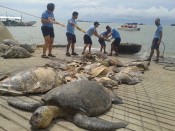
Illegal Hunting of Endangered Sea Turtles by Chinese fisherman on Philippine waters. Photo credit: ioseaturtles.org
Marine-based projects, such as the Ocean Adventure at Subic Bay and Zambales, are fostering the need for protection and propagation of endangered marine turtles and manatees (Dugong), as well as the restoration and preservation of coral reefs throughout the Philippine archipelago.
In the Pipeline. New methods in endangered marine species repopulation will be the paramount focus through the planned Marine Conservation Research and Development Center in Zambales. The center will be accessible to all academic workers and researchers from the Philippines and overseas. Also in Zambales, the Marine Turtle Hatchery Project and the Coral Reef Propagation Program, manned by Filipino and foreign volunteers, aim to provide a better future for several endangered sea turtles, and habitat protection.
Sobering Statistics. The Chelonian Research Foundation in Massachusetts finds that altogether there are currently 317 recognized species of turtles and tortoises in the world. Of those that have been assessed on the IUCN Red List, 63% are threatened, 10% are critically endangered, and 42% of all known turtle species are threatened. Without a directed strategic conservation planning, a significant portion of turtle diversity could be lost over the next century.

